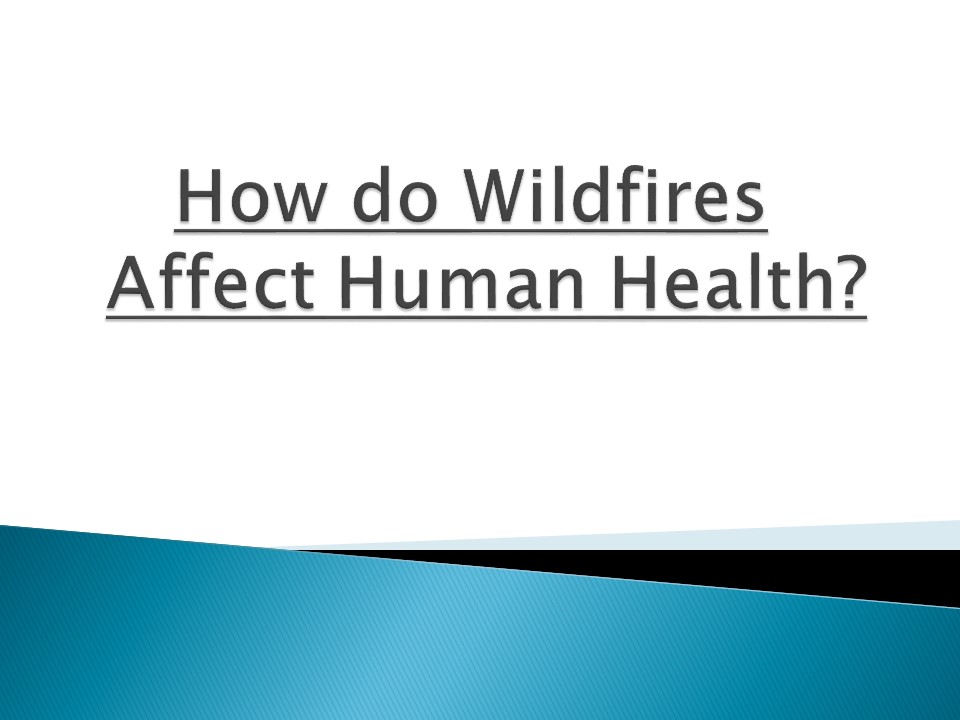How do Wildfires Affect Human Health? - PowerPoint PPT Presentation
Title:
How do Wildfires Affect Human Health?
Description:
Wildfires can occur anytime, anywhere, and are frequently brought on by human action or a natural occurrence like lightning. It is unknown how 50% of the wildfires dataset that has been reported got started. – PowerPoint PPT presentation
Number of Views:2
Title: How do Wildfires Affect Human Health?
1
How do Wildfires Affect Human Health?
2
Introduction
- A wildfire is an unauthorized fire that breaks
out in a wilderness setting like a forest,
meadow, or prairie. Wildfires can occur anytime,
anywhere, and are frequently brought on by human
action or a natural occurrence like lightning. It
is unknown how 50 of the wildfires dataset that
has been reported got started. - Extremely dry circumstances, such as drought and
strong winds, enhance the risk of wildfires.
Transportation, communication, electricity and
gas utilities, and the water supply, can all be
affected by wildfires. They also result in the
loss of resources, crops, people, animals, and
property and a decline in air quality. - Between 1998 and 2017, 6.2 million people were
impacted by wildfires and volcanic activity, and
2400 deaths from suffocation, wounds, and burns
were attributed to these events globally,
according to multiple fire databases. However,
wildfire magnitude and frequency are increasing
due to climate change. Wildfire risk is rising
due to ecosystems becoming drier and hotter
conditions. Because they release large amounts of
carbon dioxide, carbon monoxide, and fine
particulate matter into the atmosphere, wildfires
also impact weather and climate immediately.
Health concerns like respiratory and
cardiovascular disorders can result from air
pollution. The impact of wildfires on mental
health or psychosocial well-being is another
important aspect of health.
3
The impacts of wildfire smoke on health
- Many air pollutants, such as carbon monoxide,
nitrogen oxides, polycyclic aromatic
hydrocarbons, volatile organic substances (VOCs),
particulates, and ozone, are released during
wildfires database and affect human health.
However, Colleen Reid, associate professor in the
School of Geography just at the University of
Colorado Boulder, observed that most of the proof
in the epidemiologic studies literature
concentrates on particulate matter, specifically
fine particulate matter of fewer than 2.5 µm
(PM2.5). The length of a hair, which is normally
between 50 and 70 µ, or a grain of fine sand,
roughly 90 microns wide, is significantly larger
than these particles. It is feared that tiny
particles that make up most of a wildfire's smoke
plume could enter the lungs deeply and harm
living things. Particles can also excite the
nervous system's autonomic nerves and impact
cardiovascular health by producing pulmonary
inflammatory responses and oxidative stress. Even
the smallest particles can enter the bloodstream
and move around the body.
4
Considerations for wild land firefighters' health
- Before the workshop, an interdisciplinary
hot-shot crew focusing on controlled burns and
wildfires had worked with Kathleen Navarro, the
forest planning expert with the U.S. Forest
Service. - And over 27,000 firefighters were sent to the
western states to create wildfires in 2018 during
the busiest fire dataset season. Navarro noted
that they labor in trying circumstances.
Typically, a federal firefighter can only work 16
hours each day. Typically, Californian
firefighters work a 24-hour on, 24-hour off
shift. When she was working on a fire dataset,
she said, "If I am on fire, my usual day begins
at 5 a.m. for a wake-up, a briefing at 6 a.m.,
you are on the frontline by 7 a.m., 8 a.m. just
at the latest, and then you're working till 7 or
8 p.m. Return to your camp. You consume dinner.
You retire to bed. Usually, no showering. A
sturdy headgear and clothing that resists
firefighters wearing flames. They have a fire
shelter, which "is a perfect setting of aluminum
foil that can shield during a burn-over or
perhaps an entrapment," with them. There is no
respiratory protection on them. - Firefighters are subjected to smoke while on the
job and while staying in fire camps that are
frequently set up close to active flames. They
must dig fire lines extinguish fires with their
available hand tools if they are part of a hand
crew. Engine resources have a 500-gallon water
capacity and can go to places with roads.
Aviation resources can drop fire and water
retardant. Then, to support those resources,
local firefighters can enter the scene.
5
Why are there so many fires?
- Although 2015 was one of the most destructive
fire seasons in the last ten years, millions of
acres and hundreds of thousands of fires are
destroyed yearly. According to studies, climate
change has fueled the flames of these wildfires. - The chance of drought and a longer fire season
has increased due to climate change, which has
increased summer and winter temperatures and
brought on early spring snowmelt. Additionally,
these hot, dry circumstances will raise the
possibility that wildfires will be more severe
and long-burning once they start, whether from
lightning strikes or a cigarette. - Direct life-threatening wildfires and their smoke
can have an impact on everyone. They disperse air
pollution thousands of miles distant and locally,
making it difficult for even healthy people to
breathe, let alone kids, seniors, and those with
heart disease, hypertension, asthma, COPD, and
other lung conditions.































